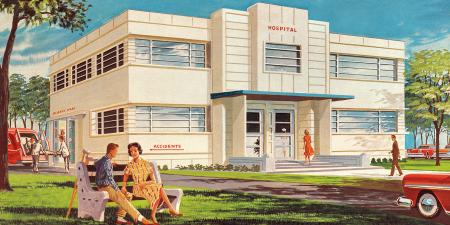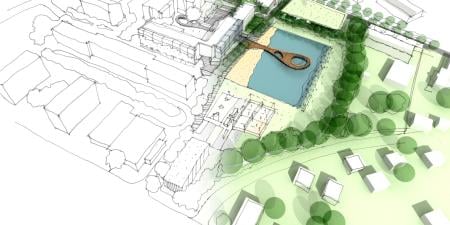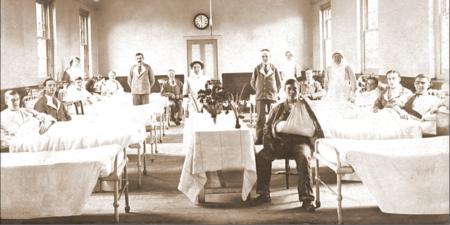Abstract
Traditional focus areas of medical education are insufficient for preparing future clinicians to function well in the rapidly evolving US health care system. In response, many medical schools and residency programs are integrating into their curricula health systems science (HSS), which includes health care policy, public and population health, interprofessional collaboration, value-based care, health system improvement, and systems thinking. To illustrate the value of HSS, the authors draw upon their experiences as a medical student immersed in HSS and as an educator facilitating students’ cultivation of HSS skills.
The Need for Health Systems Science
US health care delivery systems are rapidly and extensively changing. A significant component of this change concerns organizational structures and processes, such as shifting reimbursement models towards value-based care, increasing the use of care coordinators, and implementing patient-centered medical homes.1-3 Yet there has also been a concomitant transformation in the outlook of physicians, who are becoming increasingly aware, for instance, that what occurs outside of the clinic or hospital and in a patient’s community has a significant impact on health. As these changes require physicians to view their role and contribution to patient care in a new and different way, medical schools and residencies are faced with the corresponding challenge of changing the way students and residents are educated.
For nearly a century, medical education has focused on the basic and clinical sciences,4 but this paradigm has been changing with the emergence of health systems science (HSS). This change started in the 1990s, when increasing evidence of the high incidence of medical errors catalyzed a movement to improve care delivery models.5-7 In 1999, the Accreditation Council for Graduate Medical Education and the American Board of Medical Specialties adopted systems-based practice as one of the 6 core competencies in both undergraduate and graduate medical education.8 Medical schools slowly began to integrate quality improvement,9,10 interprofessional education and collaboration, and social determinants of health into curricula, while residency programs increased their focus on quality improvement and patient safety.11,12 However, by 2012, these systems competencies were not yet a significant component of educational programs, and educators lacked a formal framework to guide curricular redesign.13,14 Following national calls for change, many medical schools have re-envisioned a “third pillar” of medical education—HSS.13,15,16 Complementing the basic and clinical sciences, HSS includes competencies related to health care policy, public and population health, interprofessional collaboration, clinical informatics, value-based care, health system improvement, and systems thinking.15 The HSS framework is now being embraced by many medical schools, residency programs, and academic health systems to better align education with care delivery.17,18
This article draws upon the first author’s (CRD’s) experience as a medical student immersed in a comprehensive HSS curriculum and the second author’s (JDG’s) experience as a medical educator focused on advancing HSS programming to (1) describe the HSS pillar of medical education and the systems citizenship professional identity it espouses, (2) highlight how HSS competencies facilitate alignment between medical schools and communities, and (3) explore the student perspective on challenges to implementing HSS curricula.
Health Systems Science Competencies and a New Systems Citizenship Professional Identity
HSS addresses a growing need in medical education to help trainees think differently about their role in health care systems. As these systems grow increasingly complex, so does the task of providing quality patient care to individuals and populations. Additionally, large-scale health system challenges, such as increasing medical costs and the opioid crisis, pose threats that cannot be solved solely by individual physicians practicing traditional medicine.19 These issues highlight the need for physicians to be proficient in HSS competencies, which provide the roadmap necessary for them to function not only within clinical practice but within the health care delivery system as a whole. These competencies (see Table) help trainees learn how to operate effectively as a member and leader of health care teams, working to improve health systems and the quality of patient care.1
| Patient-centered care |
| Health care structures, processes, and collaboration |
| Clinical informatics, data, and tools |
| Population and public health, social determinants of health |
| Policy, payment, and economics |
| High-value care |
| Health systems improvement |
| Systems thinking |
| Change agency and management |
| Teaming |
| Leadership |
| Adapted from Gonzalo, et al13; Skochelak, et al15; and Gonzalo, et al.18 |
For example, these competencies might change how a surgery service responds to performance data indicating lower-than-expected quality measures (eg, delayed procedure start times, above-expected infection rates). Traditionally, surgery administrators would review performance metrics and disseminate recommendations for indicated changes. Yet HSS competencies such as teamwork and collaboration, health care processes, systems thinking, leadership, and health system improvement might lead individual surgeons on the team to collaborate with other clinicians and quality department teams to make transparent potential drivers of lower performance metrics and to explore potential solutions, while also reflecting on potential gaps in personal practice that could impact lower-than-expected outcomes.
Perhaps most important in the shift towards HSS is the new professional identity it promotes. With rapidly changing health care delivery models, physicians must now extend their roles as accurate diagnosticians and caregivers to become leaders of and collaborators within health care teams.20 This shift ultimately represents a change in clinicians’ professional identities, which now extend beyond individual behaviors or attributes (eg, altruism) to incorporate systems citizenship, which confers an obligation to enter into a synergistic relationship with the health care system because physicians are citizens of that system.21-24 The HSS competencies and systems citizenship identity seek to transform health care delivery and, subsequently, patient health.
The mindset and behavior associated with this identity can differ by level of training. For students, systems citizenship can involve exploring how social determinants of health and cost of care impact patients’ daily lives, identifying patients who cannot afford their medications and working with physicians to switch patients’ medications to cheaper alternatives, or helping patients with low income sign up for medical assistance programs. Residents could work with other health care professionals to identify and improve inefficiencies in clinical processes (eg, patient flow, laboratory testing utilization) or to address social and environmental factors leading to patient falls. Faculty educators might use hospital length of stay data as an impetus to review their inpatient teams’ discharge practices and collaborate with team members to proactively address the factors that keep their patients admitted for nonmedical reasons. The possible ways to apply HSS and practice systems citizenship are nearly limitless.
Aligning Medical Schools and Communities
Just as physicians need to work with other health professionals to provide team-based, high-value care, medical schools and their institutional and community partners need to collaborate more effectively to promote high-value care and population health.25,26 Medical schools have traditionally left such opportunities unexplored but should now seek ways to address the needs of the health system as a whole, the communities served by that system, and patients in their daily lives (eg, food or housing insecurity). Using the HSS framework and clinicians who espouse systems citizenship as the connecting bridge, medical schools could work with outside institutions like social work programs, community-based counseling services, and drug rehabilitation programs. The positive impacts that could result from such collaborations between institutions that treat patients and train physicians and community programs that help patients meet their day-to-day needs are numerous. Patients would likely experience increased satisfaction and improved health outcomes from the additional communication between those that provide them with various types of care, such as improved information exchange between their physician and community social worker. Medical students would receive practical support as they develop into systems citizens, perhaps from community care coordinators teaching them about transportation services available to patients without vehicles. The localities surrounding the medical school would also naturally benefit from the increased attention and resources that come with such collaborations, helping align the academic health center with its core mission of serving its community.27,28 Furthermore, as students trained in HSS competencies become physicians, the clinical workforce will increasingly become one that can proficiently collaborate with community organizations.
There are many methods for incorporating HSS into medical curricula in ways that help align students’ training with the needs of patients and communities. At the authors’ institution (Penn State College of Medicine [PSCOM]), the HSS curriculum extends across all 4 years of medical school training and focuses on understanding, improving, and functioning within the health care system.29,30 In coursework, for example, medical students serve as patient navigators with the goals of understanding patients’ needs and assisting them in their lived environments while improving both patients’ and their own ability to navigate the health care system. Additionally, these students pursue activities catalyzed by the HSS curriculum that focus on learning about and improving health systems, such as population and public health projects.31-35 For example, after a panel discussion with community leaders involved in a free medical clinic, food pantry, and transitional housing program, several students at PSCOM developed a program that was ultimately funded by the institution to provide fresh produce to at-risk patients.31 Such activities allow learners to explore the impact of the patient and community context on care delivery.
Student Perspective on Challenges to HSS Education
Based on the first author’s experiences, one reason it is challenging for students to understand the complexity of HSS is that it is fundamentally different from the basic and clinical sciences taught in medical school. While the latter tend to be fact-driven—focusing on pharmacokinetics, disease pathology, diagnostic algorithms, and so on—HSS is more experiential and is contextualized within complex, collaborative situations or environments.36 For instance, learning that social determinants of health exist and should be considered when caring for patients is easily discussed in a classroom lecture, but deeply appreciating the profound impact that these determinants can have on patient care—and how they might be practically assessed and addressed—is something much more difficult to learn through didactics. It took the first author years of medical school HSS training (and an additional year of master of public health coursework) to more fully appreciate these concepts. Students who do fully embrace this component of medical education can experience a shift in their learning processes or perspectives, changing the way they study or the questions they ask patients and preceptors.
Another challenge is that not all students believe HSS topics are worth learning in medical school. In the first author’s experience, some students do not want to receive HSS training because they simply do not believe it improves their ability to practice medicine at all; this perspective seems to stem from not fully understanding the profound impact that HSS topics like social determinants of health play in patients’ lives, as discussed in the previous paragraph. Other students might see some value in HSS training but do not value its presence in undergraduate medical education because they think it can simply be learned later in their careers, if necessary. After all, time is incredibly limited in medical school, and students are forced to prioritize what seems most important, which is rarely HSS.37,38 Instead, basic science tests, board examinations, clinical rotations, and residency preparation assume greater urgency and have a more ostensible impact on their careers, thus demanding more of their time.
Conclusion
The changing health care landscape necessitates a change in the way physicians are educated. Such a change needs to incorporate HSS competencies into medical education curricula, which will better prepare future physicians to be systems citizens who are able to contribute to the team-based, high-value care that will be expected of them. Transforming medical education is no small task and requires a significant cultural shift among students, educators, and health care professionals, but doing so is critical if medicine is to adapt to the changing demands being placed upon it.
References
- Park B, Gold SB, Bazemore A, Liaw W. How evolving United States payment models influence primary care and its impact on the quadruple aim. J Am Board Fam Med. 2018;31(4):588-604.
- Darkins A, Ryan P, Kobb R, et al. Care Coordination/Home Telehealth: the systematic implementation of health informatics, home telehealth, and disease management to support the care of veteran patients with chronic conditions. Telemed J E Health. 2008;14(10):1118-1126.
-
Nichols DE, Haber SG, Romaire MA, Wensky SG; Multi-Payer Advanced Primary Care Practice Evaluation Team. Changes in utilization and expenditures for Medicare beneficiaries in patient-centered medical homes: findings from the Multi-Payer Advanced Primary Care Practice Demonstration. Med Care. 2018;56(9):775-783.
-
Ludmerer KM. Time to Heal: American Medical Education from the Turn of the Century to the Era of Managed Care. New York, NY: Oxford University Press; 1999.
-
Kohn LT, Corrigan JM, Donaldson MS, eds; Institute of Medicine. To Err is Human: Building a Safer Health System. Washington, DC: National Academy Press; 2000.
-
Institute of Medicine Committee on Quality of Health Care in America. Crossing the Quality Chasm: A New Health System for the 21st Century. Washington, DC: National Academy Press; 2001.
- Leape LL, Brennan TA, Laird N, et al. The nature of adverse events in hospitalized patients. Results of the Harvard Medical Practice Study II. N Engl J Med. 1991;324(6):377-384.
- Guralnick S, Ludwig S, Englander R. Domain of competence: systems-based practice. Acad Pediatr. 2014;14(2)(suppl):S70-S79.
-
Levitt DS, Hauer KE, Poncelet A, Mookherjee S. An innovative quality improvement curriculum for third-year medical students. Med Educ Online. 2012;17(1):17.
- Mookherjee S, Ranji S, Neeman N, Sehgal N. An advanced quality improvement and patient safety elective. Clin Teach. 2013;10(6):368-373.
-
Association of American Medical Colleges. Behavioral and social science foundations for future physicians. https://www.aamc.org/download/271020/data/behavioralandsocialsciencefoundationsforfuturephysicians.pdf. Published 2011. Accessed August 21, 2015.
-
Interprofessional Education Collaborative. Core competencies for interprofessional collaborative practice: 2016 update. https://nebula.wsimg.com/2f68a39520b03336b41038c370497473?AccessKeyId=DC06780E69ED19E2B3A5&disposition=0&alloworigin=1. Published 2016. Accessed November 25, 2018.
- Gonzalo JD, Dekhtyar M, Starr SR, et al. Health systems science curricula in undergraduate medical education: identifying and defining a potential curricular framework. Acad Med. 2017;92(1):123-131.
- Gonzalo JD, Haidet P, Papp KK, et al. Educating for the 21st-century health care system: an interdependent framework of basic, clinical, and systems sciences. Acad Med. 2017;92(1):35-39.
-
Skochelak SE, Hawkins RE; AMA Education Consortium. Health Systems Science. St. Louis, MO: Elsevier; 2016.
-
Skochelak SE. A decade of reports calling for change in medical education: what do they say? Acad Med. 2010;85(9)(suppl):S26-S33.
- Baxley EG, Lawson L, Garrison HG, et al. The Teachers of Quality Academy: a learning community approach to preparing faculty to teach health systems science. Acad Med. 2016;91(12):1655-1660.
- Gonzalo JD, Ahluwalia A, Hamilton M, Wolf H, Wolpaw DR, Thompson BM. Aligning education with health care transformation: identifying a shared mental model of “new” faculty competencies for academic faculty. Acad Med. 2018;93(2):256-264.
- Berwick DM, Hackbarth AD. Eliminating waste in US health care. JAMA. 2012;307(14):1513-1516.
- Lucey CR. Medical education: part of the problem and part of the solution. JAMA Intern Med. 2013;173(17):1639-1643.
- Hafferty FW, Levinson D. Moving beyond nostalgia and motives: towards a complexity science view of medical professionalism. Perspect Biol Med. 2008;51(4):599-615.
- Brennan TA. Physicians’ professional responsibility to improve the quality of care. Acad Med. 2002;77(10):973-980.
- Gonzalo JD, Thompson BM, Haidet P, Mann K, Wolpaw DR. A constructive reframing of student roles and systems learning in medical education using a communities of practice lens. Acad Med. 2017;92(12):1687-1694.
- Senge PM. Systems citizenship: the leadership mandate for this millennium. Reflections. 2006;7(3):1-8.
- Gupta R, Arora VM. Merging the health system and education silos to better educate future physicians. JAMA. 2015;314(22):2349-2350.
- Thibault GE. Reforming health professions education will require culture change and closer ties between classroom and practice. Health Aff (Millwood). 2013;32(11):1928-1932.
-
Kohn LT, ed; Institute of Medicine Committee on the Roles of Academic Health Centers in the 21st Century. Academic Health Centers: Leading Change in the 21st Century. Washington, DC: National Academies Press; 2004.
-
Wartman SA. The Transformation of Academic Health Centers: Meeting the Challenges of Healthcare’s Changing Landscape. Amsterdam, The Netherlands: Elsevier; 2015.
- Gonzalo JD, Wolpaw T, Wolpaw D. Curricular transformation in health systems science: the need for global change. Acad Med. 2018;93(10):1431-1433.
- Gonzalo JD, Lucey C, Wolpaw T, Chang A. Value-added clinical systems learning roles for medical students that transform education and health: a guide for building partnerships between medical schools and health systems. Acad Med. 2017;92(5):602-607.
-
Vogelsong J. Prevention produce educates on the value of healthy eating. Penn State Medicine. October 7, 2015. https://pennstatemedicine.org/2015/10/07/prevention-produce-educates-on-the-value-of-healthy-eating/. Accessed January 2, 2019.
- George DR, Monnat S, Levine R, Blatt B, Gonzalo JD. Teaching to the opioid epidemic—an interdisciplinary approach. Med Teach. 2017;39(6):672-673.
-
McDermott CSK, Shervinskie BS, Gonzalo JD. Developing a professional identity as a change agent early in medical school: the students’ voice. J Gen Intern Med. In press.
-
Johannes B, Graaf D, Blatt B, George D, Gonzalo JD. A multi-site exploration of barriers faced by vulnerable patient populations: a qualitative analysis exploring the needs of patients for targeted interventions in new models of care delivery [published online ahead of print June 28, 2018]. Prim Health Care Res Dev.
-
Gonzalo JD, Wolpaw D, Graaf D, Thompson BM. Educating patient-centered, systems-aware physicians: a qualitative analysis of medical student perceptions of value-added clinical systems learning roles. BMC Med Educ. 2018;18(1):248.
- Cristancho S, Lingard L, Regehr G. From problem solving to problem definition: scrutinizing the complex nature of clinical practice. Perspect Med Educ. 2017;6(1):54-57.
-
Mills LM, Hoffman AB, Khan A, Lai CJ. Integrating health systems science in early undergraduate medical education: barriers to implementation and lessons learned. MedEdPublish. 2017;6(4).
- Gonzalo JD, Haidet P, Blatt B, Wolpaw DR. Exploring challenges in implementing a health systems science curriculum: a qualitative analysis of student perceptions. Med Educ. 2016;50(5):523-531.



